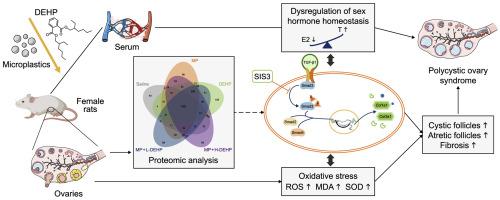Polystyrene microplastics and di-2-ethylhexyl phthalate co-exposure: Implications for female reproductive health
Abstract
Microplastics and phthalates are prevalent and emerging pollutants that pose a potential impact on human health. Previous studies suggest that both microplastics and phthalates can adversely affect the reproductive systems of humans and mammals. However, the combined impact of these pollutants on the female reproductive system remains unclear. Here we show the impacts of exposure to polystyrene microplastics (PS-MPs) and di-2-ethylhexyl phthalate (DEHP) on female Sprague-Dawley rats’ reproductive systems. We find that co-exposure to PS-MPs and DEHP results in a marked increase in cystic and atretic follicles, oxidative stress, fibrosis, and dysregulation of serum sex hormone homeostasis in the ovaries of the rats. Proteomic analysis identified differentially expressed proteins that were predominantly enriched in signaling pathways related to fatty acid metabolism and tight junctions, regulated by transforming growth factor β1 (TGF-β1). We further confirm that co-exposure to DEHP and PS-MPs activates the TGF-β1/Smad3 signaling pathway, and inhibiting this pathway alleviates oxidative stress, hormonal dysregulation, and ovarian fibrosis. These results indicate that exposure to the combination of microplastics and phthalates leads to a significant increase in atretic follicles and may increase the risk of polycystic ovary syndrome (PCOS). Our study provides new insights into the reproductive toxicity effects of microplastics and DEHP exposure on female mammals, highlighting the potential link between environmental pollutants and the occurrence of PCOS. These findings highlight the need for comprehensive assessments of the reproductive health risks posed by microplastic pollution to women and contribute to the scientific basis for evaluating such risks.


 求助内容:
求助内容: 应助结果提醒方式:
应助结果提醒方式:


